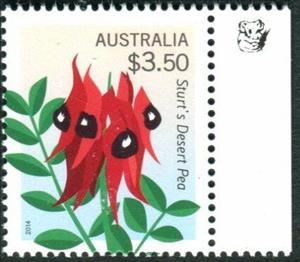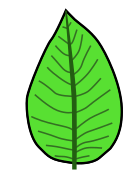Stamp with Collectible Margin: Sturt's Desert Pea (Swainsona formosa) 1st Reprint (Australia 2014)
Sturt's Desert Pea (Swainsona formosa) 1st Reprint (Australia 2014)
24 March (Australia ) within release Floral Emblems goes into circulation Stamp with Collectible Margin Sturt's Desert Pea (Swainsona formosa) 1st Reprint face value 3.50 Australian dollar
| Stamp with Collectible Margin Sturt's Desert Pea (Swainsona formosa) 1st Reprint in catalogues | |
|---|---|
| Seven Seas Stamps: | Sev: AU 3179a |
Stamp with Collectible Margin is horizontal format.
The koala reprint indicators appear in both the left and right selvedgeAlso in the issue Floral Emblems:
- Stamp - Tasmanian Blue Gum face value 70;
- Stamp - Waratah face value 70;
- Stamp - Golden Wattle face value 70;
- Stamp - Common Heath face value 70;
- Stamp - Cooktown orchid face value 1.40;
- Stamp - Kangaroo paw face value 2.10;
- Stamp - Sturt's Desert Pea face value 3.50;
- Stamp - Common Heath face value 70;
- Stamp - Common Heath face value 70;
- Stamp - Golden Wattle face value 70;
- Stamp - Golden Wattle face value 70;
- Stamp - Waratah face value 70;
- Stamp - Waratah face value 70;
- Stamp - Tasmanian Blue Gum face value 70;
- Stamp - Tasmanian Blue Gum face value 70;
- Se-tenant - Self Adhesive Strip of 4 face value 4*70;
- Se-tenant - Se-tenant Strip of 4 face value 4*70;
- Booklet - Floral Emblems face value 10*70;
- Booklet - Floral Emblems face value 20*70;
- Stamp with Collectible Margin - Sturt's Desert Pea (Swainsona formosa) 1st Reprint face value 3.50;
Stamp with Collectible Margin Sturt's Desert Pea (Swainsona formosa) 1st Reprint it reflects the thematic directions:
A flower, sometimes known as a bloom or blossom, is the reproductive structure found in plants that are floral (plants of the division Magnoliophyta, also called angiosperms). The biological function of a flower is to effect reproduction, usually by providing a mechanism for the union of sperm with eggs. Flowers may facilitate outcrossing (fusion of sperm and eggs from different individuals in a population) or allow selfing (fusion of sperm and egg from the same flower). Some flowers produce diaspores without fertilization (parthenocarpy). Flowers contain sporangia and are the site where gametophytes develop. Many flowers have evolved to be attractive to animals, so as to cause them to be vectors for the transfer of pollen. After fertilization, the ovary of the flower develops into fruit containing seeds. In addition to facilitating the reproduction of flowering plants, flowers have long been admired and used by humans to beautify their environment, and also as objects of romance, ritual, religion, medicine and as a source of food.
A leaf (pl.: leaves) is a principal appendage of the stem of a vascular plant usually borne laterally aboveground and specialized for photosynthesis. Leaves are collectively called foliage, as in "autumn foliage", while the leaves, stem, flower, and fruit collectively form the shoot system. In most leaves, the primary photosynthetic tissue is the palisade mesophyll and is located on the upper side of the blade or lamina of the leaf but in some species, including the mature foliage of Eucalyptus,palisade mesophyll is present on both sides and the leaves are said to be isobilateral. Most leaves are flattened and have distinct upper (adaxial) and lower (abaxial) surfaces that differ in color, hairiness, the number of stomata (pores that intake and output gases), the amount and structure of epicuticular wax and other features. Leaves are mostly green in color due to the presence of a compound called chlorophyll which is essential for photosynthesis as it absorbs light energy from the sun. A leaf with lighter-colored or white patches or edges is called a variegated leaf.
Flora is the plant life occurring in a particular region or time, generally the naturally occurring or indigenous—native plant life. The corresponding term for animal life is fauna. Flora, fauna and other forms of life such as fungi are collectively referred to as biota. Sometimes bacteria and fungi are also referred to as flora, as in the terms gut flora or skin flora.



